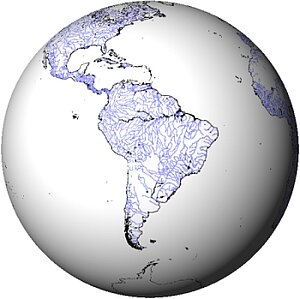Hydrology and Land
The earliest altimetry missions were dedicated to studying the open ocean and some ice measurements. However, every stretch of water (enclosed seas, lakes, rivers, flooding areas...) or even flat surfaces over lands can give valid data - as long as the satellite fly over them. Swot will change drastically the latter point, with a near-complete, high resolution monitoring of the continents (except Antarctica).
Satellite altimetry has the advantage of being able to take global, homogeneous, repeated measurements, unhindered by clouds, night or even vegetation, thus enabling systematic monitoring to be carried out over several years. The measured surface heights are referenced to the same frame. However, classical radar altimetry technique has been mainly optimized for the ocean and takes measurements only at the nadir (i.e. just under below the satellite), with a rather narrow footprint -- and averaging everything in that footprint. Specific processing can be applied to retrieve all the possible data. Moreover, the satellite acquisition modes have been improved since 2017 so that the altimeter can be in a receiving mode over lands using a Digital Elevation Model. Over non-ocean surfaces (wet or dry), the accuracy of the altimetry measurements can be degraded by several centimetres or tens of centimetres, mainly because of the heterogeneity of the reflecting surface (a mix of water and emerged land surfaces), and because of reflections on the river banks. Another important source of error lies in the propagation of the signal through the atmosphere. It must also be noticed that the satellites repeat-orbits are rather long (10 to 35 days), which do not fit real-time monitoring of river or lake level variations (e.g. flood alerts), but agree well with seasonal or interannual monitoring.
Further information:
- Hydroweb
- Copernicus Land Service - Global, Water level product
- OSTST meeting posters and presentations
- Poster : Lakes and rivers under the altimeter's watchful eye (pdf)
- Swot, a satellite for hydrology.
- ECHOS team at Legos (Legos/CNRS, France).
- Global Reservoir and lake monitor (U.S. Department of Agriculture, USA)
- Document on How to use altimetry for hydrology? (advanced level) (also in Spanish, Portuguese, French)


















